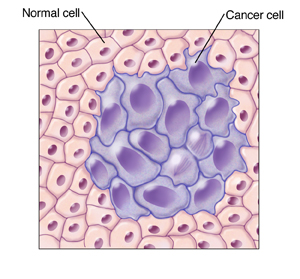Cancer in Children: An Overview
Cancer in Children: An Overview
Your child has been diagnosed with cancer. You are likely feeling shocked and scared. But, you are not alone. Support and treatment are available. Your child’s healthcare team will help you and your child every step of the way.
What is cancer?
Cancer is a disease in which the body’s cells grow abnormally. Normally, cells grow at a steady rate. But with cancer, the cells grow out of control. With some cancers, the cells join together and form a lump of tissue called a tumor:
Malignant tumors. These tumors often grow fast and destroy healthy tissue. Malignant tumors can be metastatic. This means they can spread to other areas of the body.
Benign tumors. These are tumors that are not cancer. Benign tumors may be locally invasive. This means they don’t spread and affect only 1 area of the body. But they may still need treatment.
What causes cancer?
Unlike cancer in adults, the cause of cancer in children is often not known. Parents of children with cancer often blame themselves, but cancer in children is no one’s fault. Changes in certain genes, called mutations, may affect the way your child’s cells grow. This gene mutation is random and couldn’t have been prevented. In rare cases, other factors, such as exposure to certain viruses, chemicals, or radiation, play a role. It is very rare than cancer in children may be hereditary and may be more likely to happen in certain families.
What are the symptoms of cancer?
There is no single set of symptoms for cancer. Instead, your child’s symptoms depend on the type of cancer and where the cancer is found.
How is cancer diagnosed?
Your child may have had a number of imaging tests to diagnose cancer. More tests still may be needed. Your healthcare team can tell you more about any tests your child needs.
Staging and grading of cancer
Staging is the process that tells the size of the cancer and how much it has spread. Most cancers have their own staging system. Grading is used to describe how abnormal the cancer cells look when seen through a microscope. The more abnormal the cells are, the faster they grow. Staging and grading help the healthcare team plan treatment for your child. They also help determine the likelihood of a cure (prognosis). Staging and grading systems may look at the following:
Location of the primary tumor
Tumor size and number of tumors
If the cancer has spread to other areas of the body (metastasis)
How abnormal the cancer cells look under a microscope
For many cancers, the stages are written as Roman numerals and can have a value of I through IV (1 through 4). The stage numbers refer to the tumor’s size and how much it has spread. For instance, stage I is an early stage of cancer in where the cancer has not spread much. And stage IV is the most widespread. But many cancers are broken down into further classifications. Your healthcare provider can tell you more if needed and answer any questions you have about the stage of your child’s cancer.
How is cancer treated?
Childhood cancers are often more curable than cancer in adults. The goal of treatment is to attack the abnormal cells, while hurting as few of the healthy cells as possible. To treat the cancer, your child may require more than one therapy. These may include the following:
Chemotherapy to kill cancer cells or shrink tumors using strong medicine. This treatment usually requires several sessions and has side effects. These can include tiredness, hair loss, nausea, and vomiting. But medications are available to help treat certain side effects.
Surgery to remove all or part of a tumor.
Radiation to kill cancer cells or shrink tumors using high-energy waves.
It’s important that you follow your child’s treatment schedule as directed. Be sure to keep all your child’s healthcare appointments.
What is the likely outcome for my child?
The likelihood of cure may depend on the following:
The presence of symptoms related to the type of cancer
Type and stage of the cancer
Size and location of the tumor (if a tumor is present)
How the cancer cells look under a microscope
If the cancer has spread
The child’s age and overall health
The cancer’s response to treatment
How well the child responds to medications, procedures, or therapies
Coping
You’re likely feeling many emotions right now. This is normal. Remember that you are not alone. Your child’s healthcare team will work with you and your child throughout your child’s illness and care. You may also want to seek information and support for yourself. Learning about and talking with others who also have a child with cancer may help you and your family cope with the changes cancer brings. Some helpful resources include:
Children's Oncology Group www.childrensoncologygroup.org
American Cancer Society
www.cancer.orgCancerCare
www.cancercare.orgAmerican Childhood Cancer Organization
www.acco.orgCaringBridge
www.caringbridge.orgChildren’s Cancer Association
www.childrenscancerassociation.orgNational Cancer Institute
www.cancer.govCureSearch for Children’s Cancer
www.curesearch.orgNational Children’s Cancer Society
www.nationalchildrenscancersociety.org
Updated:
August 08, 2018
Reviewed By:
Image reviewed by StayWell medical illustration team.,Levy, Adam, S., MD,Sather, Rita, RN
